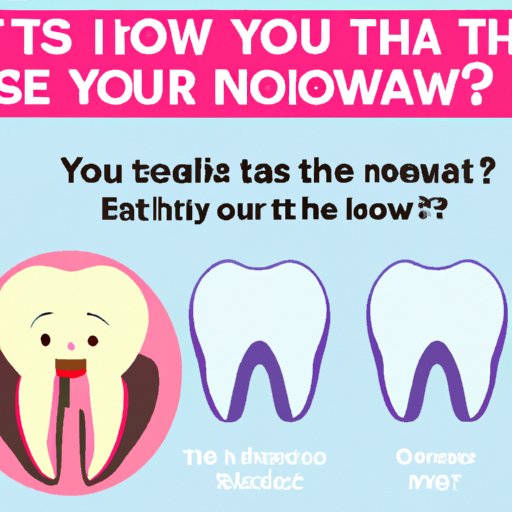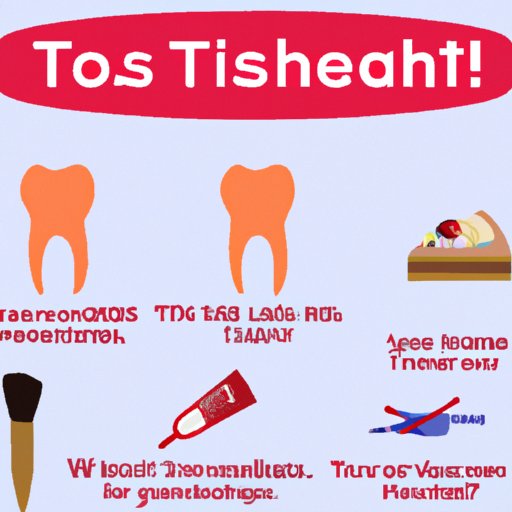
Introduction
Knowing if you have cavities is important for maintaining proper dental health. Cavities, otherwise known as tooth decay, occur when the enamel of your teeth deteriorates due to bacteria. If left untreated, cavities can lead to tooth loss, gum disease, and more serious health problems. This article will explore the top signs and symptoms of cavities, how dentists diagnose cavities, what to expect at a dental checkup, and how to prevent cavities from forming in the first place.
5 Telltale Signs That You Might Have a Cavity
One of the most obvious signs of tooth decay is visible pits or holes in your teeth. However, there are other indications that you may have a cavity:
A. Visible holes or pits in the teeth
If you see any small holes or pits on the surface of your teeth, this may indicate a cavity. These holes can range in size and shape and are usually brown, black or grey in color. If you notice any pits or holes, it is best to make an appointment with your dentist immediately.
B. Sensitivity to hot or cold
If you experience pain or sensitivity when drinking or eating hot or cold foods and beverages, this may suggest you have a cavity. The sensitivity will often continue even after you have stopped eating or drinking hot or cold items.
C. Pain when biting down
If you feel pain or discomfort when you bite down, this is another indication that you might have a cavity. This is because when you bite down, you’re applying pressure to the affected tooth which may cause pain or discomfort.
D. Toothache
One of the most common and obvious signs of a cavity is a toothache. This is often a dull, throbbing pain that doesn’t go away on its own. If you experience a toothache, it’s important to see your dentist as soon as possible.
E. Stains on the surface of the teeth
If you notice stains or discoloration on your teeth, this could indicate tooth decay. These stains can be black, brown or white and are often a sign that a cavity has been forming for some time.
The Top Symptoms of Tooth Decay to Watch Out For
While the above symptoms are the most common signs of cavities, there are other symptoms to be aware of:
A. Bad breath
Bad breath that persists even after brushing or using mouthwash could suggest the presence of a cavity. This is because bacteria can breed on the tooth surface that is decaying and cause an unpleasantly odor.
B. Unpleasant taste in the mouth
If you have a persistent unpleasant taste in your mouth that doesn’t go away, this could suggest the presence of tooth decay. This taste is often metallic or sour and won’t disappear even after brushing your teeth and using mouthwash.
C. Dark spots on the teeth
If you notice dark spots on your teeth, these could be early signs of tooth decay. These spots may be hard to see and may even look like stains, but they usually indicate a cavity is forming beneath the surface of the tooth.
D. Pus around the tooth
A sign that your tooth decay is more severe is when you notice pus around the affected tooth. This may suggest an infection in the tooth, which can lead to more severe symptoms if left untreated.
E. Swollen gums
Swollen, red, or bleeding gums are another sign that you may have tooth decay. When your gums become inflamed, it means that bacteria has entered the gum line and is causing damage to the tooth and gums. Schedule an appointment with your dentist immediately if you experience any of these symptoms.
The Most Common Ways Dentists Diagnose Cavities
If you suspect you have a cavity, the best course of action is to visit your dentist. There are several ways in which your dentist can diagnose if you have a cavity:
A. Visual exam
During a visual exam, your dentist will examine your teeth for signs of decay. They will use a small mirror to look for visible holes or pits on the surface of your teeth.
B. X-rays
X-rays are commonly used to help diagnose cavities that may not be visible during a visual exam. X-rays are able to detect decay between teeth and other hard-to-see areas.
C. Using an explorer tool
A dental explorer tool is a small metal instrument that dentists use to detect cavities. The tool can identify any soft or sticky areas around the teeth that may indicate tooth decay.
D. Laser cavity detection
Laser cavity detection is becoming more common in dental practices. The laser can detect early signs of decay by measuring the fluorescence of your teeth to see whether there are any changes suggestive of tooth decay.
What to Expect at a Dental Checkup to Detect Cavities
To maintain optimal dental health, it’s essential to schedule regular dental checkups. During these checkups, your dentist will look for signs of tooth decay and other dental problems. Here’s what you can expect during a dental checkup:
A. The importance of regular dental checkups
Regular dental checkups can help prevent cavities and gum disease. Most dentists recommend visiting the dentist at least twice a year to get a thorough examination of your oral health.
B. Overview of the steps involved in a dental checkup
During a dental checkup, your dentist will look at your teeth, gums, and mouth to ensure there are no potential problems. They will also ask about any symptoms or changes in your oral health.
C. Explanation of what the dentist looks for during a checkup
Your dentist will look for signs of cavities, gum disease, oral cancer, and other dental problems. They may also take X-rays to check for hidden problems.

7 Things That Could Be Causing Your Toothache
While cavities are a common cause of toothaches, they are not the only explanation for this type of pain. Here are seven things that could be causing your toothache:
A. Cavities
The most common cause of toothaches is cavities. When tooth decay causes holes in your teeth, it can lead to sensitivity and pain.
B. Gum disease
Gum disease is an infection of the gums. Symptoms of gum disease include bleeding gums, bad breath, and a dull ache in the tooth.
C. Cracked or broken teeth
If you have cracked or broken teeth, you may experience tooth pain. The severity of the pain depends on the severity of the damage to the tooth.
D. Bruxism
Bruxism, or teeth grinding, can cause tooth sensitivity and pain. Grinding your teeth wears down the tooth enamel, making them susceptible to decay and pain.
E. Dental Abscess
Dental abscesses are bacterial infections that usually occur as a result of untreated cavities. An abscess can cause a severe toothache, fever, and swollen gums.
F. Sinus Infection
If you have a sinus infection, this can cause pain in your teeth. The roots of your upper molars are in close proximity to your sinuses, and inflammation from a sinus infection can lead to tooth pain.
G. Temporomandibular Joint (TMJ) Disorder
TMJ disorder can cause pain in your teeth and jaw. This disorder causes dysfunction in the joints that connect your jaw to your skull, resulting in pain and discomfort.
How to Maintain Good Oral Hygiene to Prevent Cavities
It’s always better to prevent tooth decay from occurring in the first place. Here are some tips on how to maintain good oral hygiene and prevent cavities:
A. Brushing
Brush your teeth twice a day using fluoride toothpaste. Make sure to brush for at least two minutes and don’t forget to brush your tongue.
B. Flossing
Floss at least once daily to remove any food debris that may be stuck between your teeth.
C. Using mouthwash
Rinse your mouth with an antimicrobial mouthwash to kill any bacteria left in your mouth after brushing and flossing.
D. Diet and Nutrition
Limit your intake of sugary and acidic foods, as these foods can wear down your tooth enamel and cause decay. Instead, eat a healthy, balanced diet that includes plenty of fruits and vegetables, and drink plenty of water.
E. Avoiding Tobacco and Excessive Alcohol Consumption
Smoking and chewing tobacco can lead to a host of dental problems, including cavities. Excessive alcohol consumption can also contribute to tooth decay. Avoiding tobacco and limiting alcohol consumption can help prevent cavities.
Conclusion
Tooth decay can lead to serious dental problems if left untreated. It’s essential to know the signs and symptoms of cavities, to see a dentist regularly, and to maintain good oral hygiene. By taking the necessary steps to protect your teeth, you can prevent cavities and maintain optimal dental health.





